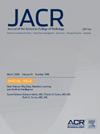密苏里州乳腺癌筛查、筛查率和数字乳腺断层合成法律变化协会。
IF 5.1
3区 医学
Q1 RADIOLOGY, NUCLEAR MEDICINE & MEDICAL IMAGING
引用次数: 0
摘要
目的:评估密苏里州法律变更的相关性,将乳房x光检查的覆盖范围扩大到包括从40岁开始的年度筛查(以前是从50岁开始的两年一次),数字乳房断层合成(DBT)对总体筛查率和DBT的使用。方法:本回顾性研究(2015-2022)使用国家索赔数据库(Inovalon Insights, LLC)。在逻辑回归模型中使用差异中的差异方法来评估密苏里州法律变化与女性筛查可能性的关系,以及那些接受DBT的可能性。密苏里州内部的模型将医疗补助和商业病人与联邦监管的医疗保险优势(MA)计划的受益人进行了比较。通过将密苏里州的患者与密苏里州边境各州的患者进行比较,进一步测试了这种联系,但保险范围没有变化。结果:密苏里州共有1008881名女性,占41.4%[417835]。密苏里州法律变更后,享受医疗补助的女性(比值比[OR]: 1.45;95%置信区间[CI]: 1.36-1.55)和商业保险(OR: 1.05;95% CI: 1.01-1.10)与基于联邦法律的MA妇女相比,筛查乳房x光检查的可能性更高。接受过乳房x光检查的医疗补助妇女在密苏里州内发生DBT的可能性更高(OR: 2.31;95% CI: 2.01-2.66)和边界状态(OR: 1.24;95% CI: 1.22-1.27)比较。同样,有商业保险的妇女接受DBT的可能性也相对增加。结论:密苏里州法律扩大乳腺癌筛查覆盖率的变化与医疗补助患者筛查率的增加以及医疗补助和商业保险患者中DBT可能性的增加密切相关。本文章由计算机程序翻译,如有差异,请以英文原文为准。
Association of Changes in Missouri Law for Breast Cancer Screening, Screening Rates, and Use of Digital Breast Tomosynthesis
Objective
To estimate the association of Missouri law changes expanding mammography coverage to include annual screening from age 40 (previously biennial from age 50), digital breast tomosynthesis (DBT) on overall screening rates, and use of DBT.
Methods
This retrospective study (2015-2022) used a national claims database (Inovalon Insights, LLC). A difference-in-differences approach was used in logistic regression models to assess the association of changes in Missouri law with women’s likelihood of screening, and for those screened, the likelihood of receiving DBT. Within-Missouri models compared Medicaid and commercial patients to beneficiaries of federally regulated Medicare Advantage (MA) plans. The association was further tested via a comparison of Missouri patients to their counterparts in Missouri border states without a coverage change.
Results
There were 1,008,881 unique women (41.4% [417,835] in Missouri). After the Missouri law change, women with Medicaid (odds ratio [OR]: 1.45; 95% confidence interval [CI]: 1.36-1.55) and commercial insurance (OR: 1.05; 95% CI: 1.01-1.10) had a greater increase in likelihood of screening mammography compared to MA women whose coverage is based on federal law. Medicaid women with mammography had a higher likelihood of DBT for both within-Missouri (OR: 2.31; 95% CI: 2.01-2.66) and border-state (OR: 1.24; 95% CI: 1.22-1.27) comparisons. Commercially insured women likewise had a relative increase in likelihood of receiving DBT.
Conclusion
Changes in Missouri law expanding breast cancer screening coverage were strongly associated with increased screening rates among Medicaid patients as well as increased likelihood of DBT among screened patients, for both Medicaid and commercially insured patients.
求助全文
通过发布文献求助,成功后即可免费获取论文全文。
去求助
来源期刊

Journal of the American College of Radiology
RADIOLOGY, NUCLEAR MEDICINE & MEDICAL IMAGING-
CiteScore
6.30
自引率
8.90%
发文量
312
审稿时长
34 days
期刊介绍:
The official journal of the American College of Radiology, JACR informs its readers of timely, pertinent, and important topics affecting the practice of diagnostic radiologists, interventional radiologists, medical physicists, and radiation oncologists. In so doing, JACR improves their practices and helps optimize their role in the health care system. By providing a forum for informative, well-written articles on health policy, clinical practice, practice management, data science, and education, JACR engages readers in a dialogue that ultimately benefits patient care.
 求助内容:
求助内容: 应助结果提醒方式:
应助结果提醒方式:


